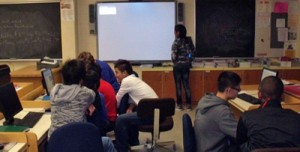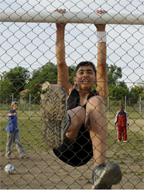School jurisdictions throughout Canada, the US, the UK, Australia and New Zealand have developed specialized programs to address the needs of students who enter school at older ages with backgrounds of limited previous schooling. Here are a few examples that illustrate innovative responses to meeting the needs of this group of learners.
 In Calgary, Alberta, the LEAD (Literacy, English and Academic Development) Program is offered in 11 locations, for students with limited formal schooling in grades 4-12. Students receive sheltered instruction for up to two years as they are gradually integrated into inclusive classrooms. For more information, see Description of LEAD program. The LEAD program teachers and administrators have been instrumental in contributing materials to this website and are in the process of developing new materials to share. See the Sample Units page.
In Calgary, Alberta, the LEAD (Literacy, English and Academic Development) Program is offered in 11 locations, for students with limited formal schooling in grades 4-12. Students receive sheltered instruction for up to two years as they are gradually integrated into inclusive classrooms. For more information, see Description of LEAD program. The LEAD program teachers and administrators have been instrumental in contributing materials to this website and are in the process of developing new materials to share. See the Sample Units page.
The Manhattan Comprehensive Night and Day High School in New York City offers expanded learning opportunities for SIFE (Students with Interrupted Formal Education) students ages 17 to 21. The school offers flexible scheduling in order to allow for accelerated skills development and credit accumulation, with accommodations for adult life demands (such as work, childcare, and family responsibilities.) Classes run during a traditional schedule as well as on evenings and weekends. In addition to extensive language support, the school offers weekend academic programs and a comprehensive summer school. Working in partnership with a community-based organization, the school also provides social and psychological services, employment counseling, and college admission support to all students.
In Manitoba, nine school jurisdictions offer Intensive Newcomer Support Programs, which provide specialized intensive language, literacy, fundamental academic skills and cultural orientation, for a period of 6 months to 2 years. The programs cluster newcomer students or take a cohort approach in a low-enrollment classroom, provide multi-grade and multi-age appropriate programming, and provides specialized programming for a minimum of 50% of the instructional day, distinct from the universal and targeted ELL support provided. School districts are provided with guidelines for applying for programming grants.
In Boise, Idaho the Language Academy offers a newcomer program. The students take courses in core content and learn English through a sheltered content model. Additional supportive services such as counseling, physical education, and social work are available. There is also a “youth mentor” who serves as a male role model for students and facilitates service learning projects. Students may attend the academy for up to four semesters. When they transition out of the academy, all schools continue English language development support along with other activities to support the successful integration of refugee and immigrant youth into their home schools.
The BRYCS (Bridging Refugee Youth and Children’s Services) website offers a searchable database of promising practices in the United States.




